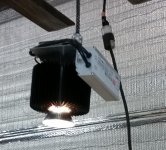steamandsteel
Aluminum
- Joined
- Oct 21, 2017
- Location
- Wichita, KS
Hello,
Looking to outfit a new 40 x 40 shop with lighting. Currently has some dismal fluorescent that work about as well as you'd expect, especially with the cold.
Big fan of screw-in LED bulbs and spotlights, and can get them fairly reasonable (few dollars per bulb)
Just ran across some 4ft LED "shop lights" drawing 40w, putting out 4100 lumens - picked one up and they seem pretty reasonable. Cheap too, at $15 per 4-ft section, linkable as well.
There will be milling, turning, and welding operations in this shop. I'm looking to light the shop up as a whole, area lighting for individual machines may be tackled later.
Currently leaning towards the 4ft linkable lights, due to their light output and price point, but does anyone have any other thoughts or experience on the matter? Going to be starting with a clean slate, so I am open to any and all suggestions and stories from guys that "wish they would've done it this way"
Looking to outfit a new 40 x 40 shop with lighting. Currently has some dismal fluorescent that work about as well as you'd expect, especially with the cold.
Big fan of screw-in LED bulbs and spotlights, and can get them fairly reasonable (few dollars per bulb)
Just ran across some 4ft LED "shop lights" drawing 40w, putting out 4100 lumens - picked one up and they seem pretty reasonable. Cheap too, at $15 per 4-ft section, linkable as well.
There will be milling, turning, and welding operations in this shop. I'm looking to light the shop up as a whole, area lighting for individual machines may be tackled later.
Currently leaning towards the 4ft linkable lights, due to their light output and price point, but does anyone have any other thoughts or experience on the matter? Going to be starting with a clean slate, so I am open to any and all suggestions and stories from guys that "wish they would've done it this way"




